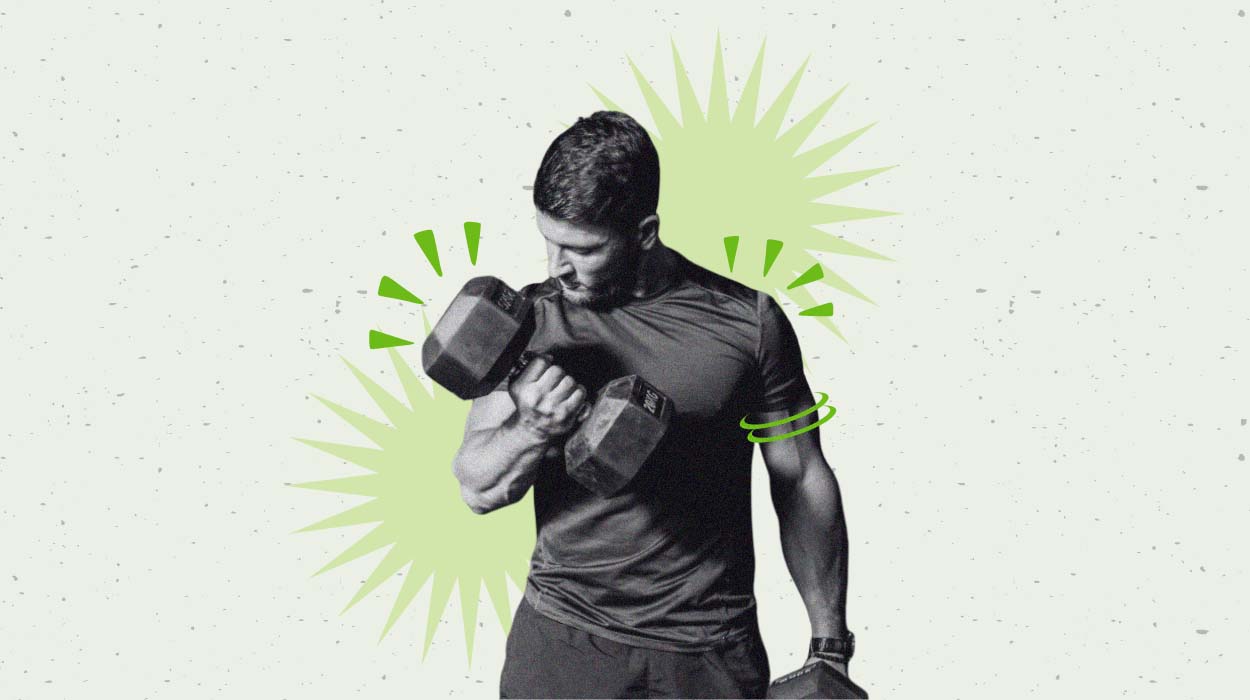
Arm and shoulder workouts help support good posture. Working these muscle groups further helps balance lower and upper body strength, contributing to full body lean muscle. Plus, research indicates that muscle mass is a predictor of longevity [1] in older adults.
Healthy muscle helps prevent injuries, contributes to better functional movement, and even burns more calories than fat at rest. So, what is the best shoulder and bicep workout you can do?
In this article, we offer you the ultimate bicep and shoulder workout where you’ll feel the burn and grow some serious muscle. Let’s get working.
Best Shoulder & Bicep Workout For Muscle Mass In 2024
Shoulder & Bicep Workout For Muscle Mass
This upper body workout for women and men challenges the upper arm muscles. Each exercise has options to adapt to your fitness level.
Some of these exercises can further be incorporated into cable shoulder workouts or a barbell arm workout, depending on the equipment available to you. So, let’s dig into these shoulder and arm exercises.
Standing Dumbbell Biceps Curls
Bicep curls focus on the flexion movement, targeting the biceps brachii and brachioradialis.[2] The anterior deltoid muscle also plays a role in the stabilization of this movement.
If you intend to do a short head bicep exercise, you may want to opt for a barbell with a wider grip.
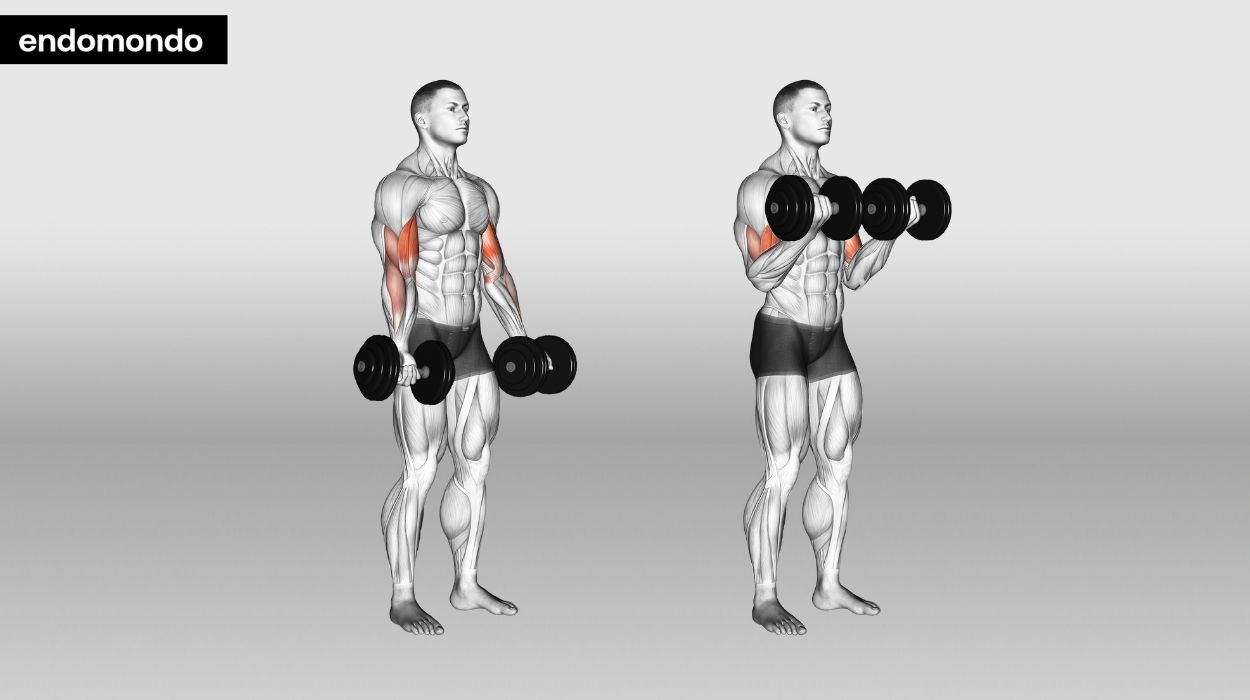
How to do:
- Stand tall with your feet shoulder width apart.
- Hold a dumbbell in each hand with your arms relaxed at your sides and your palms facing forward.
- Keeping your elbows glued to your sides, bend your elbow.
- Bring your hand and the dumbbells up to your shoulders.
- Pause, then lower back down.
Tips:
- Make sure to engage the core and maintain an upright spine.
- Don’t allow your elbows to move from your sides.
- Don’t shrug your shoulders; keep your shoulders down and back throughout the movement.
- Keep the movement slow and controlled all the way through.
Optimal Sets & Reps: 3-4 sets & 6-12 reps.
Standing Dumbbell Lateral Raises
Lateral raises work the anterior and lateral deltoids of the shoulder. This exercise can enhance strength and even range of motion, supporting one of the most vulnerable joints in the body, the shoulder.
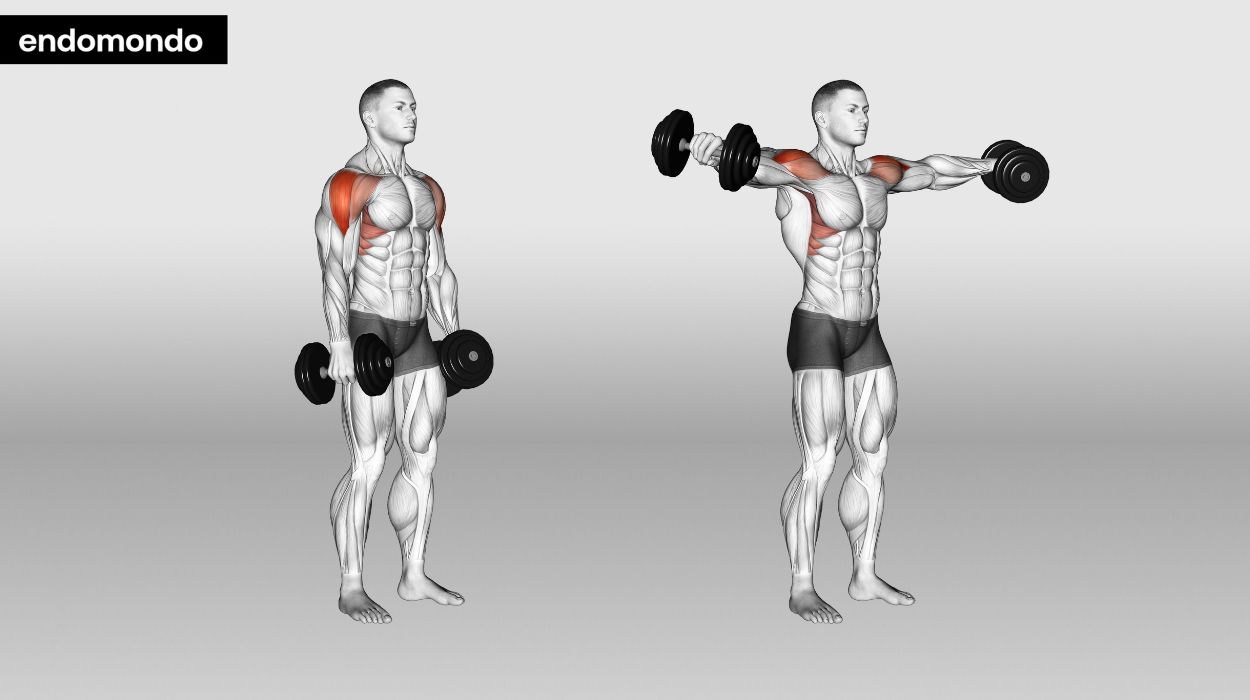
How to do:
- Stand tall with your feet shoulder width apart.
- Hold a dumbbell in each hand at your sides.
- Keeping your shoulders down and back and your elbows straight, but not locked, bring your arms up to shoulder height.
- Pause, then slowly lower.
- Repeat for the desired number of repetitions and sets.
Tips:
- Don’t lock the elbows but also keep your arms straight.
- Engage the core to maintain an upright posture.
- Gently pinch the shoulder blades down and back to maintain good posture.
- Start with lighter weights and gradually increase weight to avoid injury.
Optimal Sets & Reps: 3-4 sets & 6-12 reps
Standing Dumbbell Overhead Press
The muscle groups worked in the overhead press include the chest, shoulders, and triceps. This exercise can also be done using a barbell. If dumbbells are unavailable, try the next exercise, the military press, instead.
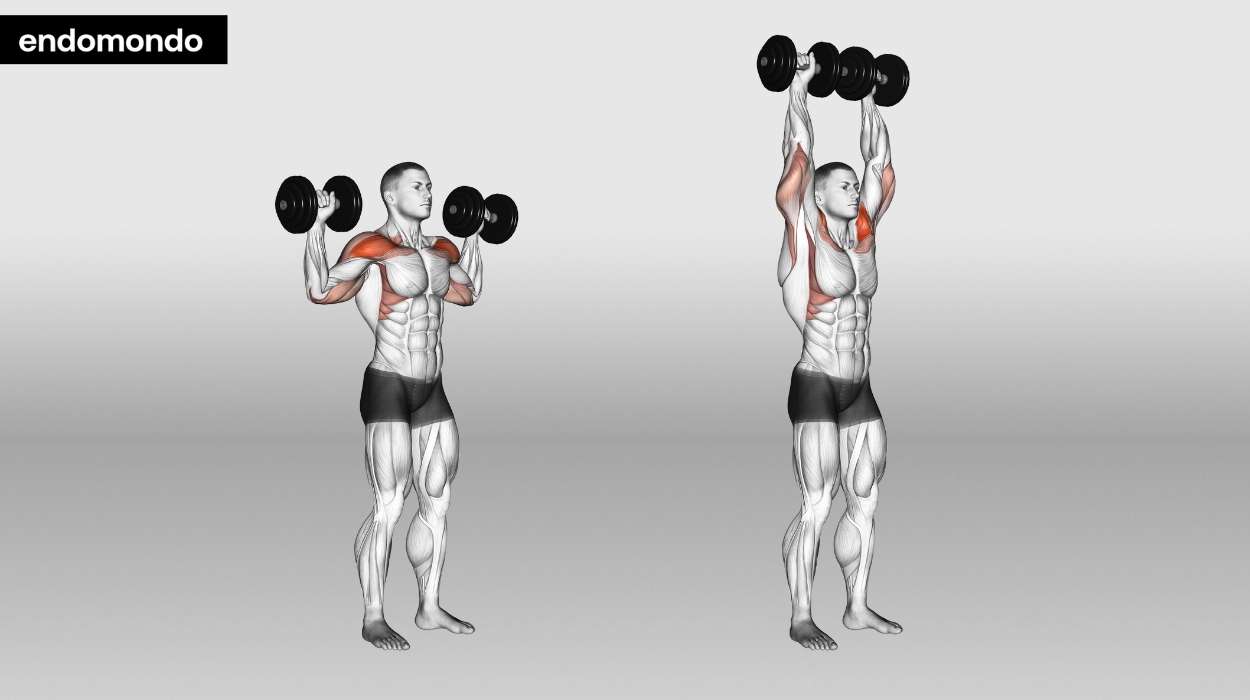
How to do:
- Start with your feet hip width apart and a slight bend in your knees.
- Starting with a lighter weight, position your upper arms at shoulder height with a bend in your elbows and palms facing forward.
- Slowly push up until your arms are straight.
- Lower back down, then repeat.
Tips:
- Keep your knees slightly bent, but don’t use your lower body to push up.
- If you have shoulder impingement issues, use a starting position where your pinkies are facing forward. As you push up, turn the palms to face forward. Then, do the reverse on the way down.
- Engage the core to maintain a good posture.
- Don’t shrug the shoulders up toward the ears.
Optimal Sets & Reps: 2-3 sets & 6-12 reps
Standing Barbell Military Press
This exercise works the deltoids in the shoulders, as well as the triceps and the trapezius muscles in the upper back. The core is also engaged, as this exercise requires quite a bit of stabilization.
Since there are many overhead movements in this workout, we recommend sticking to only two to three sets per overhead exercise. We don’t want to overwork the shoulders.
So, let’s learn how to perform a standing barbell military press.
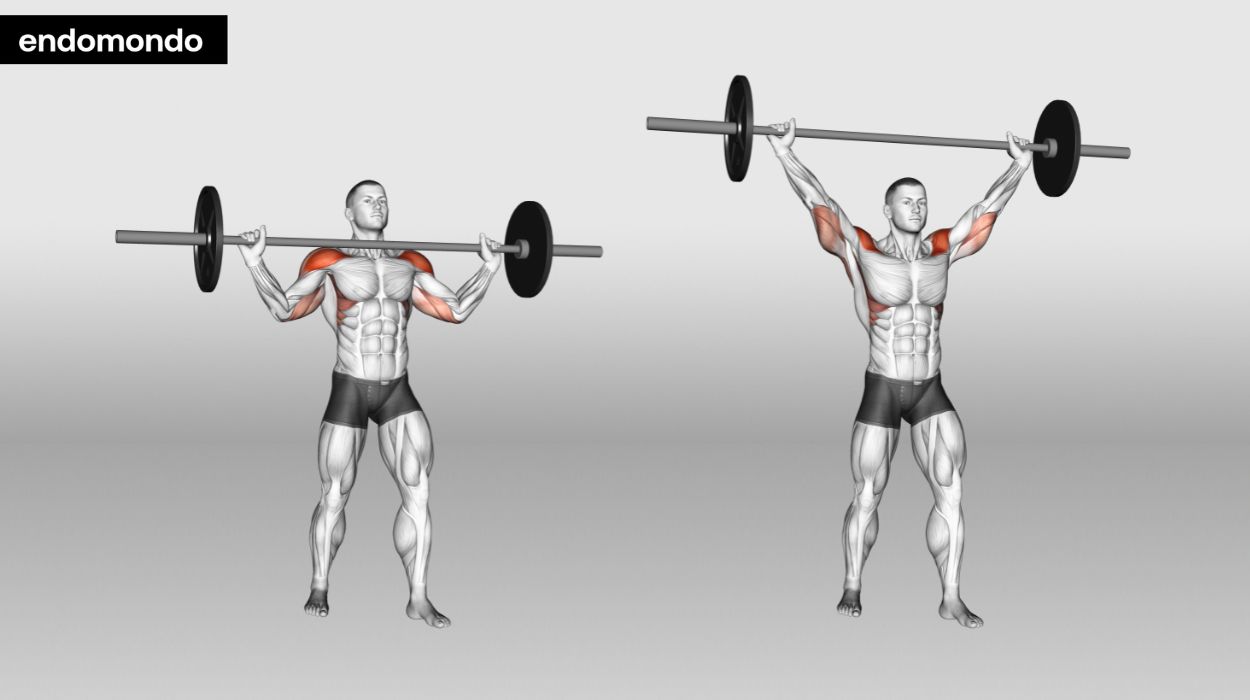
How to do:
- Line up the barbell with your upper chest.
- Grab the bar with your palms forward and elbows bent, and slightly bring your body under the bar.
- Lift the bar off the support, then step backward, planting your feet wider than shoulder width apart.
- Push the bar up overhead.
- Slowly lower the bar back down until it’s just resting on your upper chest.
Tips:
- Make sure to brace the core and slightly engage the glutes.
- Ensure you are pushing through the shoulders and arms and not through the legs.
- Perform the entire movement in a slow and controlled manner.
- Keep your elbows in line with your ears; don’t allow them to move forward or backward.
Optimal Sets & Reps: 2-3 sets & 6-12 reps
Standing Dumbbell Front Raises
This is similar to how lateral raises target the lateral deltoid. Front raises target the anterior deltoid. Considering that the number of anterior shoulder dislocations are high [3] in young, active individuals, this is a must on your shoulder and bicep day.
Like other exercises on this list, make sure to start with lighter weights before progressing to heavy weights. As previously mentioned, this is because injury is common and easy to come by with shoulder movements.
Start with getting your form down first, then increase your weight. From here, you can gradually increase your weight over time to gain strength in the shoulder muscles.
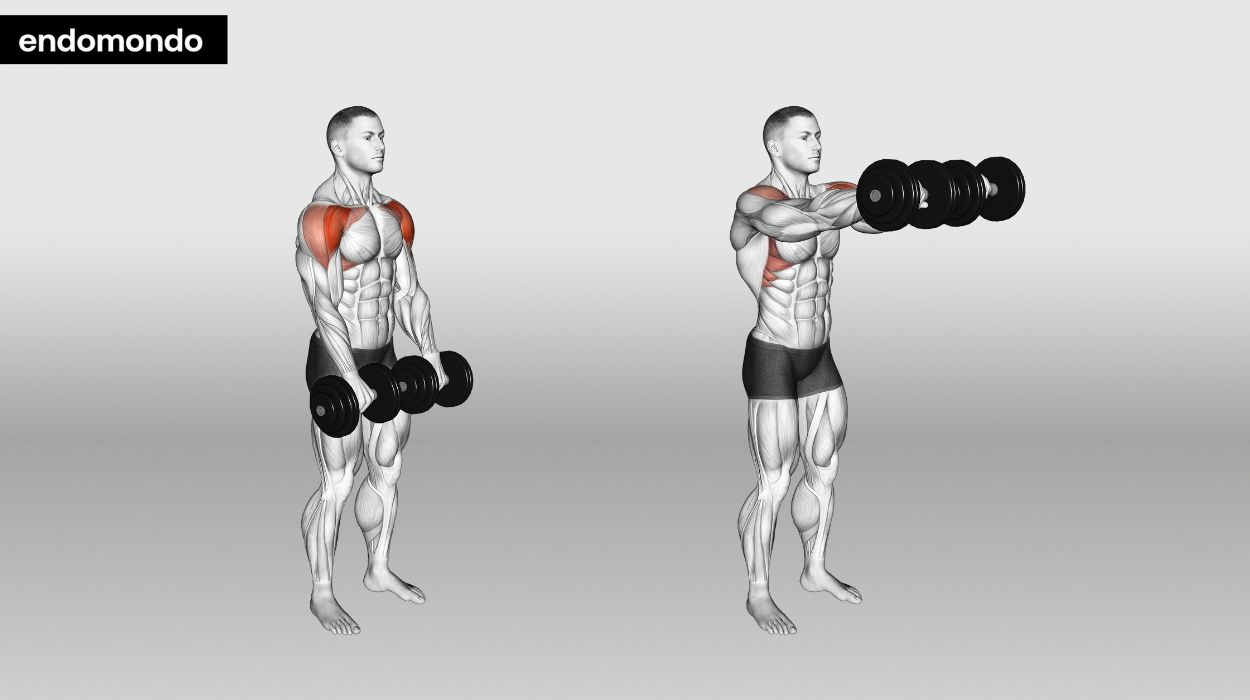
How to do:
- Start standing tall with your feet hip width apart.
- Hold a dumbbell in each hand with your arms relaxed in front of your body.
- Keeping your elbows straight, but not locked, bring your arms up until they are parallel with your shoulders.
- Pause at the top, then slowly lower.
Tips:
- Don’t use momentum to perform the movement.
- Go slow and stay in control of the entire movement.
- Engage your core to maintain your posture and protect your back.
- Keep your shoulder blades down and back for proper posture.
Optimal Sets & Reps: 3-4 sets & 6-12 reps
Standing Dumbbell Upright Rows
This exercise engages the shoulders, upper back, and core. In particular, it works the rear deltoid, which can round out movements targeting the lateral or anterior deltoids.
This is also a great exercise to incorporate into your arm workouts; it can support other movements, like deadlifts, bench presses, pull ups, and more. In fact, many bodybuilders, including Arnold Schwarzenegger, regularly include this one in their routines.
The key is to do this one right. Unfortunately, when done incorrectly, this is another movement that can seriously injure the vulnerable shoulder joint. This, again, means getting your form down before adding heavier weights.
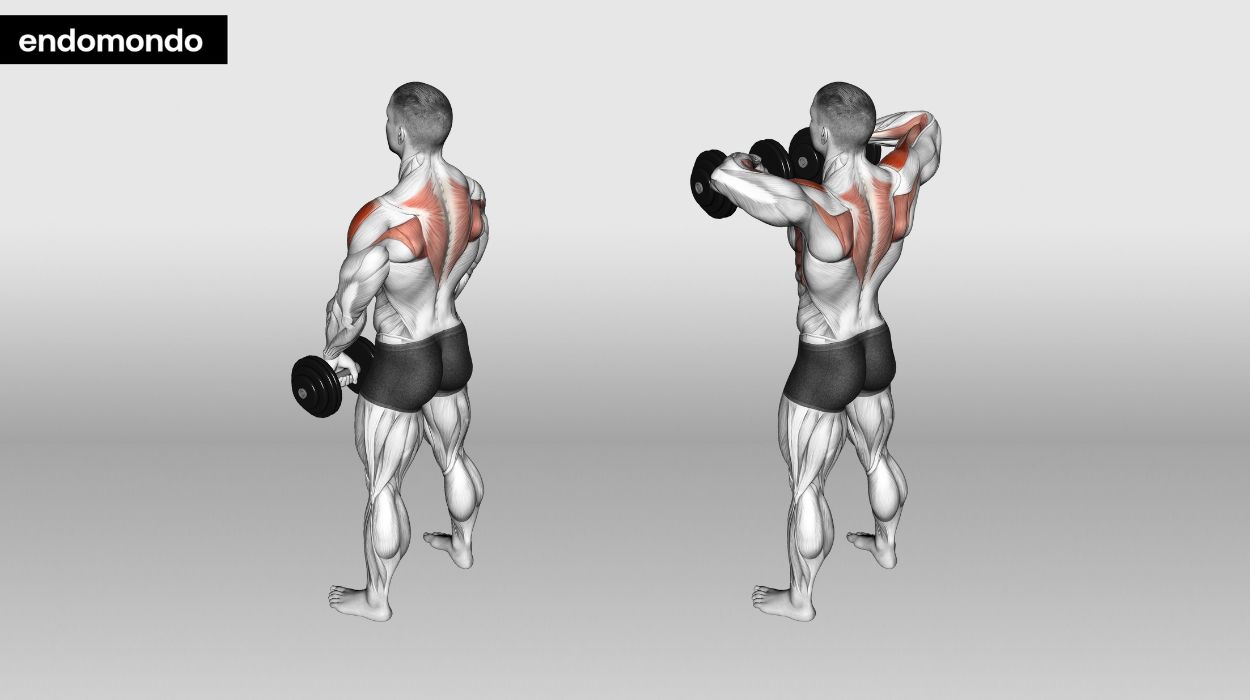
How to do:
- Stand with your feet hip distance apart.
- Hold a dumbbell in each hand with your palms facing inward.
- Bring the dumbbells slightly up vertically, bending your elbows.
- When your elbows are right below your shoulders, pull back, squeezing your shoulders and bringing your hands toward your face.
- Lift the weights just parallel to your shoulders.
- Slowly lower back to the starting position.
Tips:
- Make sure to engage your core and glutes to avoid moving the back or compromising posture.
- Squeeze your shoulders blades down and back throughout the movement.
- Don’t pull the weights higher than your shoulders; this may lead to shoulder impingement injuries.[4]
- Focus on pulling up, then back.
Optimal Sets & Reps: 3-4 sets & 6-12 reps
Standing Dumbbell Shoulder Shrugs
This one builds your shoulders and upper back muscles, such as the trapezius. This can lead to better stability in the shoulders. Again, this has the benefit of muscle growth, increased strength, and likely fewer injuries. It’s also a really simple one to do.
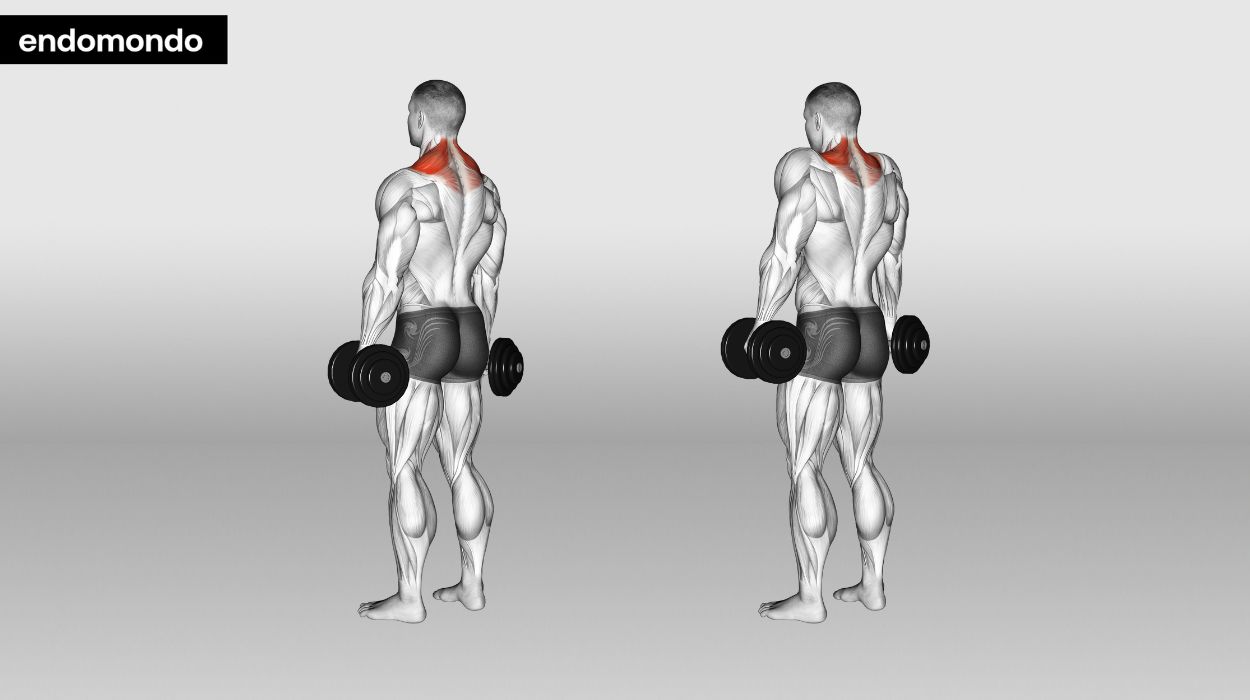
How to do:
- Start standing tall with a dumbbell in each hand at your sides and your palms facing inward.
- Pinch your shoulders blades down and back.
- As you breathe out, shrug your shoulders up toward your ears.
- Breathe in and slowly lower your shoulders.
- Then, repeat.
Tips:
- Maintain a neutral spine throughout the movement.
- Keep your shoulder blades pinched down and back the whole time.
Optimal Sets & : Reps 3-4 sets & 6-12 reps
Standing Dumbbell Hammer Curl
For long head bicep exercises, the hammer curl is an excellent twist on the basic bicep curl. On top of targeting this part of the biceps, it also works the forearms. In turn, this can add strength when bending the elbow, preventing injury or pain.
So, how can you do the standing dumbbell hammer curl?
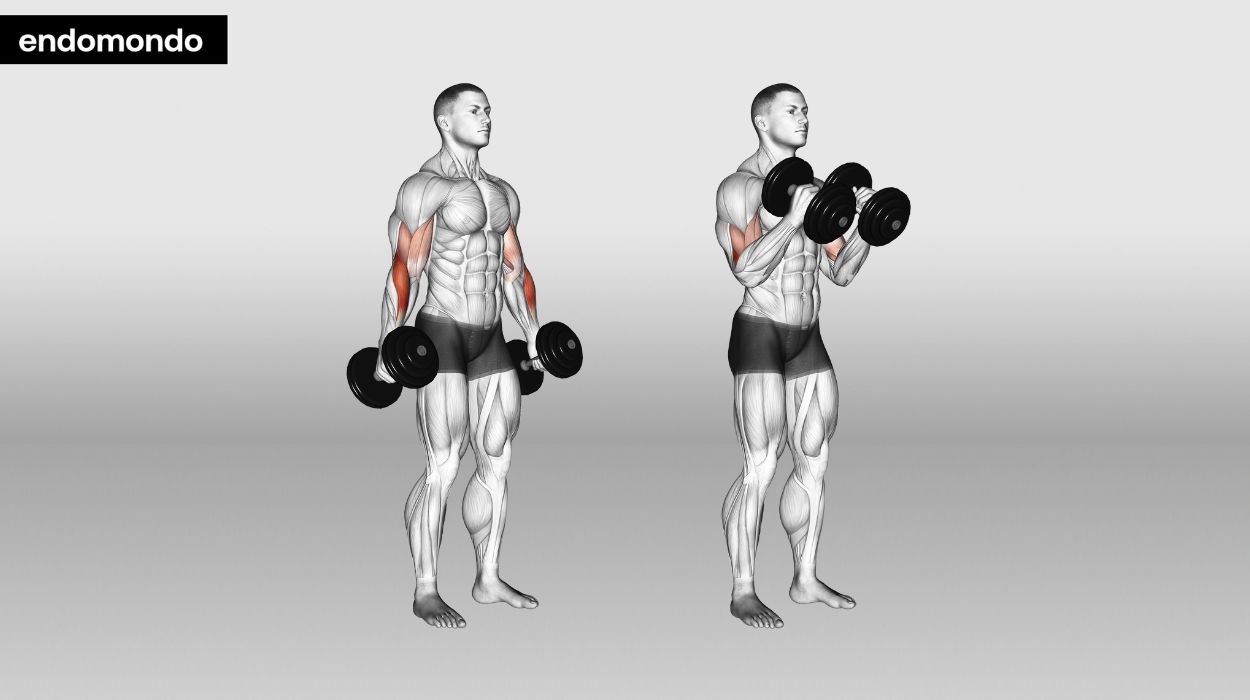
How to do:
- Start standing tall with your feet hip width apart.
- Hold a dumbbell in each hand at your side.
- Keep your thumbs facing forward, bend your elbows, and bring your hands up toward your shoulders.
- Pause, then lower back down to start.
Tips:
- Avoid any swinging of the hips by engaging your core.
- Maintain a neutral spine.
- Go slow through the movement to enhance time under tension.
Optimal Sets & Reps: 3-4 sets & 6-12 reps
Bodyweight Chin Ups
Chin ups should never be underrated, especially when it comes to working the biceps and shoulders. In fact, this exercise targets almost the entire upper body muscle groups. In other words, you’re getting the most bang for your buck.
However, chin ups can be hard to do. The good news is that with some practice, they aren’t impossible. Some gyms even have chin up machines where you can slowly build up to your body weight.
So, how do you perform a chin up exactly?
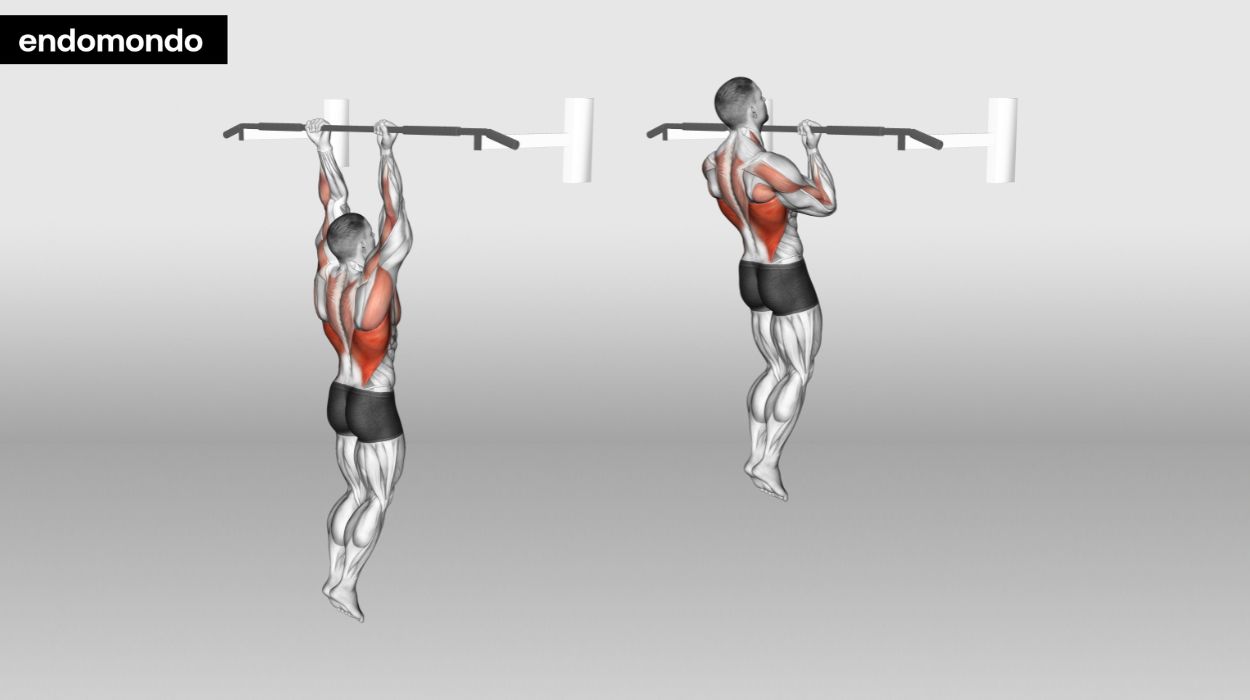
How to do:
- Stand under a chin up bar and grip it with your hands about shoulder width apart.
- Holding onto the bar with an underhand grip, pull up until your chin is just above the bar.
- Slowly lower back down, and repeat.
Tips:
- Engage your core throughout the movement.
- Aim to use your full range of motion for every rep.
- Don’t shrug your shoulders.
- Stare straight ahead, not up or down.
Optimal Sets & Reps: 2-3 sets, 8-15 reps
Your Shoulders & Biceps Anatomy
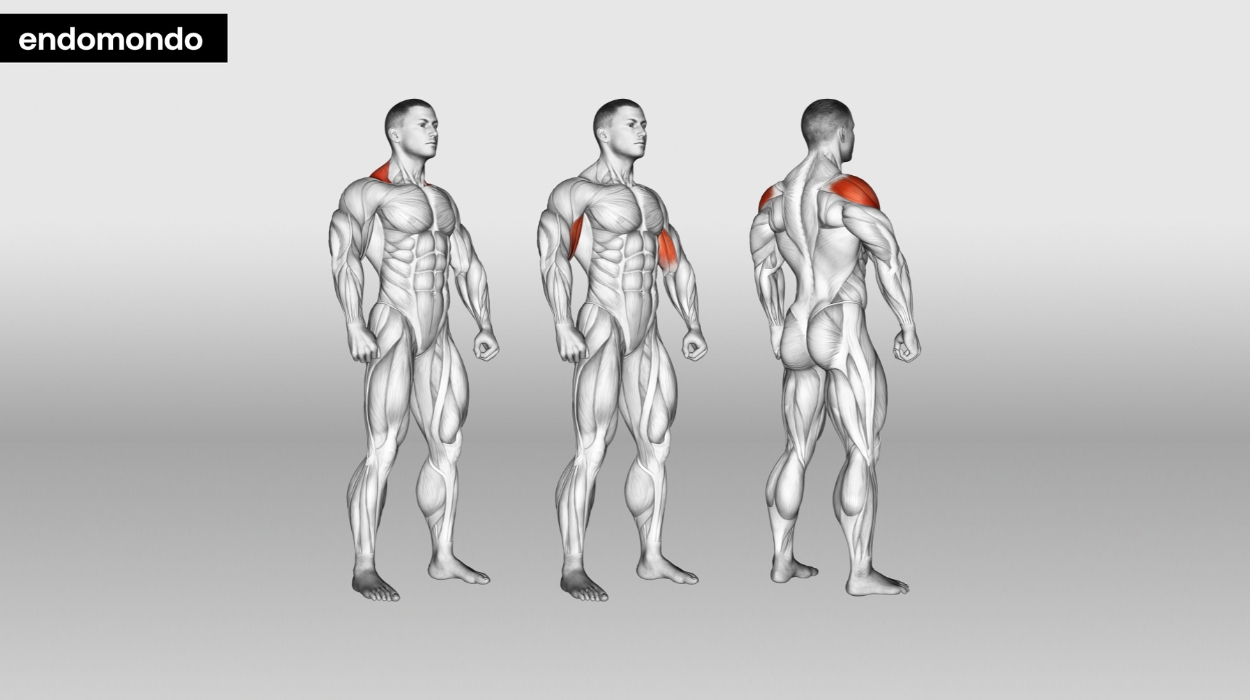
The shoulder is a ball-and-socket joint. This means the head of the upper arm bone, the humerus, fits into a socket composed of the scapula and collarbone. The rotator cuff muscles are the primary stabilizers of the shoulder, supporting it throughout various movements.
Yet, muscles involved in scapulae stabilization,[5] such as the trapezius, may contribute to further stability of the rotator cuff. This is further suggested when injury to the rotator cuff muscles has occurred as part of a comprehensive rehab program.
On top of the rotator cuff muscles, we have the biceps brachii, which extends from the shoulder to the elbow. Meanwhile, the deltoid muscles, including the posterior deltoid, anterior deltoid, and medial deltoid, allow your arms to move in all different directions.
Reasons You Train Shoulders & Biceps Together
Just like a chest and arms workout saves time and is ultra-efficient, working shoulders and biceps together also offers an efficient workout breakdown. This is because many exercises engage both the shoulders and biceps, making it easy to do a two-in-one.
Working them together also means you won’t fatigue one before getting to it in another workout or vice-versa.
Shoulder & Biceps Workout Tips
If you’re new to shoulder and biceps workouts, here are a few tips to help you get started:
- Go light at the start and gradually increase your lifting weight from there.
- Get your form and technique down first to avoid injury.
- Avoid swinging the weights during movements.
- Always begin with a warm-up, such as dynamic upper body stretches.
- Make sure to give your muscles time to rest between workouts.
Wrapping Up
A shoulder and biceps workout is a great addition to any fitness routine. Often, it’s recommended that you perform these workouts at least twice a week for maximal muscle gains. If at any point you experience pain, it may be best to back off until the pain subsides. This way, you can progress toward your goals free of injury and discomfort.
Frequently Asked Questions
Yes, it’s recommended to combine shoulder and bicep workouts together. This is because many exercises work both muscle groups.
Some of the most effective shoulder and bicep movements include bicep curls, raises, and overhead presses.
Many people combine either shoulders and biceps or shoulders and chest. Many of the same exercises work both. Additionally, it may be beneficial to add tricep movements, such as lateral head tricep exercises, to balance the arms.
This may depend on your goals. However, considering the shoulders are the bigger muscle group, it may be beneficial to start with exercises targeting these muscles first.
Resources
- Srikanthan, P. and Karlamangla, A.S. (2014). Muscle Mass Index As a Predictor of Longevity in Older Adults. The American Journal of Medicine, 127(6), pp.547–553. doi:https://doi.org/10.1016/j.amjmed.2014.02.007.
- Coratella, G., Tornatore, G., Longo, S., Toninelli, N., Padovan, R., Esposito, F. and Cè, E. (2023). Biceps Brachii and Brachioradialis Excitation in Biceps Curl Exercise: Different Handgrips, Different Synergy. Sports, [online] 11(3), p.64. doi:https://doi.org/10.3390/sports11030064.
- Hasebroock, A.W., Brinkman, J., Foster, L. and Bowens, J.P. (2019). Management of primary anterior shoulder dislocations: a narrative review. Sports Medicine – Open, 5(1). doi:https://doi.org/10.1186/s40798-019-0203-2.
- Kolber, M.J., Cheatham, S.W., Salamh, P.A. and Hanney, W.J. (2014). Characteristics of Shoulder Impingement in the Recreational Weight-Training Population. The Journal of Strength & Conditioning Research, [online] 28(4), pp.1081–1089. doi:https://doi.org/10.1519/JSC.0000000000000250.
- Dubé, M.-O., Arel, J., Paquette, P., Roy, J.-S., Desmeules, F. and Gagnon, D.H. (2022). Co-creation of an exercise inventory to improve scapular stabilization and control among individuals with rotator cuff-related shoulder pain: a survey-based study amongst physiotherapists. Archives of Physiotherapy, 12(1). doi:https://doi.org/10.1186/s40945-022-00132-7.




